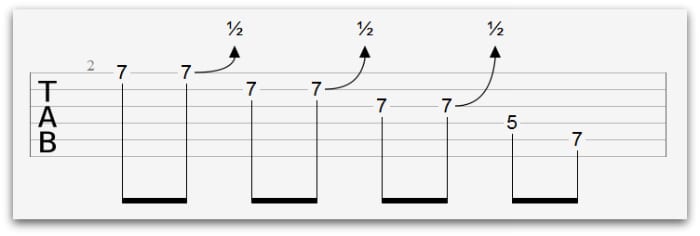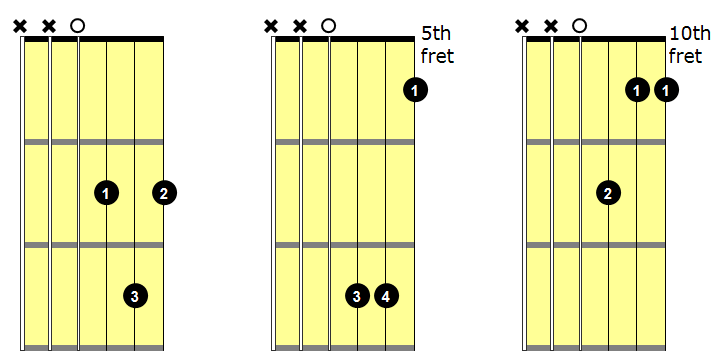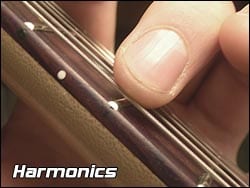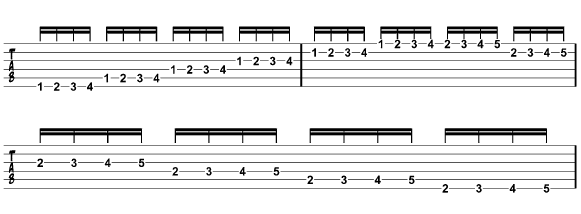6) Guitar Techniques: String Bending
String bending is what that sound is in a blues where it sounds like a note is being stretched.
It’s popular in a lot of other styles too.
To do a string bend we don’t merely press the string against the fret. We bend it as well, changing the pitch of the note.
To learn how to string bend, watch this video:
Here’s a tab of some bends you could try.
The ‘1/2’ instruction means that we’re bending the note by a half-step.
This means the note should end up sounding like it’s one fret higher than it is.
7) Guitar Techniques: Finger-picking
This one is great for acoustic guitarists. Done right, it can sound like a whole flurry of different notes coming at us at once.
To finger-pick, we pluck the guitar strings using our fingers rather than a guitar pick.
For more information on finger-picking, check out this article: Fingerstyle Guitar Lessons – 5 Easy Ways To Sound Amazing
8) Guitar Techniques: Pick Slides
If you’ve ever noticed that whooshing, scraping sound on a hair metal record, that’s usually the sound of a guitarist sliding the edge of their pick down the strings.
This technique is fairly self-explanatory, but it’s best to use the edge of the pick and to slide it down one or more of the wound strings on the guitar to get that cool scraping sound.
The non-wound strings will be a bit too smooth.
To learn how to do this killer guitar technique, watch this video:
9) Guitar Techniques: String Slapping
This is a technique that’s more popular on bass than on guitar.
To ‘slap’ a string we simply hit it with the bony part of the thumb instead of picking it with a pick.
10) Guitar techniques: Dead Notes
You know that ‘chaka chaka’ sound you sometimes hear guitarists play? Especially with a load of wah-wah effect on the guitar?
What they’re playing there is called ‘dead notes’.
To play dead notes, all we do is mute the strings of the guitar with our fretting hand and strum them with our strumming hand, producing a purely percussive and ‘dead’ sound rather than actual notes.
It’s a very simple technique, but it can be quite effective.
Sometimes, dead notes are added in amongst a bucnh of ordinary notes or chords to provide a bit of variation.
Want free guitar tips and video lessons delivered to your inbox?
Join over 250,000 guitar learners and subscribe to our guitar-tips-by-email service. (It's free.)
We'll send you a series of lessons that will move you to the next level of your guitar journey.
Learn how everything fits together quickly, easily and effectively. We share ninja tips (for instant fun!) but also timeless fundamentals that will deepen your understanding.
Our Guitar Courses
To become a better guitarist click here to see our guitar courses
Get your personalised guitar-learning plan 🎸
Want us to make a guitar-learning plan that is customised to you? Click here for GuitarMetrics™
11) Guitar Techniques: Fast Alternate Picking
Ever heard a very fast burst of notes on the guitar? More than likely, you’ve just heard some very fast alternate picking.
Alternate picking is how we should practice all our scales. It simply means alternating between down and upstrokes of the pick when playing notes, not just using all down strokes (or all up strokes for that matter).
One of the advantages of alternate picking is that it allows us to play faster.
To learn how to alternate pick, watch this video:
For a more in-depth look at alternate picking, check out this article: Alternate Picking
✅ Stop struggling. Start making music. ✅ Learn beginner-friendly versions of every chord. This is our most popular guide and it will improve your chord ability quickly! 😎 Get a custom guitar-learning plan here: Click here for GuitarMetrics™ Learn from the world's best guitar educators: Click here for our guitar coursesLearn 12 EASY beginner chords with our popular guide

Get your own personalised guitar-learning plan 🎸
World-Class Guitar Courses 🌎
12) Guitar Techniques: Palm Muting
Palm muting is a great way to make your playing sound ‘huge’.
It allows you to control the dynamics of your playing without having any volume, tone or effect settings.
To palm mute, you simply bring the palm of your strumming hand very slightly onto the strings, so as to dampen or mute them slightly.
You can use this technique for both single notes and chords. It sounds great with power chords.
Want to learn power chords? Check out this article: How To Play Guitar Power Chords
13) Guitar Techniques: Tapping
Tapping is a lot like hammer-ons and pull-offs, except it uses the fingertips of the picking hand rather than the fretting hand.
It is often combined with hammer-ons and pull-offs such as in this video of Andy tapping an A minor arpeggio:
Here’s the tab if you’d like to try it:
14) Guitar Techniques: Alternate Chord Voicings
Ever heard a familiar sounding chord sequence but somehow the guitarist is making those chords sound different?
It’s likely they’re using alternate chord voicings.
As a guitarist, you are by no means limited to just one way of doing a chord.
For example, here’s a set of different voicings for the D major chord:
If you have several bars of D in a row, try changing the voicing to add variety.
To learn this chord in more detail, go here:
15) Guitar Techniques: Natural Harmonics
Harmonics are very pure notes that give us a bell or chime-like sound.
To play a basic harmonic, go to the twelfth fret on any string and, rather than fretting the note down, simply touch it very lightly and pick it with the pick.
This should give you a harmonic.
It’s important to be directly over the fretwire, NOT over the wood bit in between where we’d normally fret a note.
The string should NOT be touching either the fret or the fretboard either. Just your fingertip.
You can also produce harmonics at the fifth, seventh and sometimes ninth frets, but the twelfth fret is the easiest and best place to start.
16) Guitar Techniques: Pinched Harmonics
Also called ‘artificial harmonics’, there’s a couple of different ways to pinch harmonics.
We’ll look at the most precise way first.
If we get a harmonic at the twelfth fret, then if we fret our string at the first fret this will shift our harmonic up by one fret as well: to the thirteenth fret.
But how are we going to play that harmonic if our other hand is busy fretting a note?
Answer: we need to pinch it.
We do this by holding the pick between our thumb and second finger and touching the string with our index finger just over the thirteenth fret.
That way, when we pick, we get our harmonic.
If you want to see pinched harmonics in action, Nils Lofgren is an absolute master of them!
Check out his solo at around 2.59 to see some awesome pinched harmonics:
Nils uses a thumb pick, thus making it easier for him to pinch those harmonics as he doesn’t have to grip the pick with his thumb and second finger.
The other, perhaps much more common way to pinch harmonics is much less precise and involves simply catching the string with the edge of the thumb as you pick the string.
We don’t usually bring our picking hand over to the fretboard for this sort of pinched harmonic, rather we keep it in the normal picking position.
For this reason, we don’t have useful markers to show us where the harmonic is, so we have to guess/learn where they are.
These sort of pinched harmonics sound great with a load of distortion on them and as such, are sometimes called “screamers”.
17) Guitar Techniques: Body Slapping
This is strictly an acoustic guitar technique. Slap the body of a solid-body guitar and you’re in for disappointment!
Hitting the guitar may seem easy (and perhaps tempting if you’re a frustrated beginner), but hitting it in such a way that it sounds musical is a bit more of a challenge.
An absolute master of body-slapping is Andy McKee.
In this piece, he combines body slapping with a number of the other techniques we’ve looked at here such as string slapping, tapping, finger-picking and harmonics:
NB: This is a VERY advanced piece. Please don’t expect to be able to learn something like this in five minutes!
Notice how the front bit of the guitar body (known as ‘the table’) produces a deep bass drum-esque sound, whereas the edge of the guitar body produces a higher more woodblock-esque sound?
You don’t have to play anything as complicated as Andy Mckee to incorporate body slapping into your playing. Try something simple first. Perhaps add the odd percussive sound into some of the empty space in a song.
18) Guitar Techniques: Chromatic Speed
Chromatic speed is often what you’re hearing when you hear a very fast burst of notes from a guitarist.
To play chromatic speed, you first need a solid grasp of alternate picking.
Here’s a tab:
The idea is to play an exercise, such as this as fast as possible.
The trick is to first alternate pick on an open string as fast as you possibly can and then try and play the exercise at that speed, seeing if your other hand can keep up.
This can be very tricky and is definitely an advanced technique.
At first, you may find yourself playing a lot of unintentional deadnotes, but eventually, with practice, your fretting hand will catch up with your picking hand.
If you struggle to do the whole exercise in one go, try just sticking to the first four notes until you get the hang of the technique.
We call this ‘chromatic speed’ because you’ll notice it isn’t using scale patterns, rather it’s using notes that are all directly next to each other.
When played slowly, this doesn’t sound very musical at all, but when played quickly, and in contrast to slower more scale oriented playing, it can be very effective.
What Type of Guitarist Are You?
Take our 60-second quiz & get your results: Take The Quiz
Join the world's best online guitar school 🌎
- Get your own personalised guitar learning plan (customised just for YOU).
- World-class online guitar courses. Learn at your own pace.
- Community Campus & Learning Forum - A friendly community! Connect with our team & students. 😊
- Beginner Song library with chordsheets, tabs and tips. (Songs suitable for all levels!)
- Regular live streams, seminars and Q&A sessions - Learn from world-class guitar educators. Get all your questions answered!
Click here to learn more about National Guitar Academy membership 
Cool Guitar T-shirts 😎
Look cooler! Check out our merch: Click here to see our merch store
Want free guitar tips and video lessons delivered to your inbox?
Join over 250,000 other guitar learners and subscribe to our guitar-tips-by-email service. (It's free.)
We'll send you a series of lessons that will move you to the next level of your guitar journey.
Learn how everything fits together quickly, easily and effectively. We share ninja tips (for instant fun!) but also timeless fundamentals that will deepen your understanding.

Popular Lessons
How To Learn Guitar: An 11-Step Programme For Beginners
How To Choose The Perfect Beginner Guitar
More Cool Guitar Stuff
Learn about National Guitar Academy: About Us
Visit our YouTube channel for fun guitar videos.
Join us on Facebook for daily guitar tips.
Listen to our Learn Guitar Podcast for rapid guitar progress.
Check out our free chord lessons.
Get our best guitar tips & videos
Where should we send it?
Get our best guitar tips & videos








